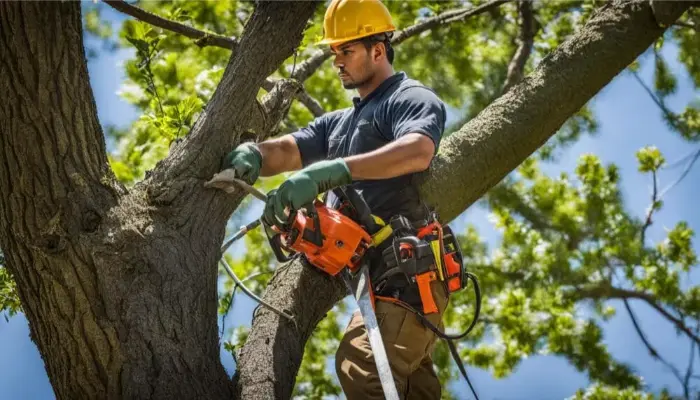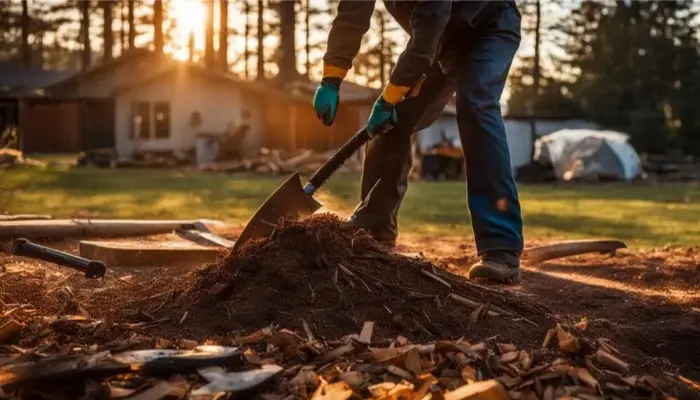As a homeowner, the lush foliage in your backyard may be one of your property’s crown jewels. But with ownership comes responsibility, especially when it involves the natural giants standing tall on your land. This homeowner tree removal guide is crafted to navigate you through the necessary steps for optimal tree maintenance, ensuring tree removal safety, and understanding the comprehensive tree removal process. When the time comes, knowing how to proceed with licensed tree removal or seeking professional tree removal services will have you equipped to handle arboricultural tasks of any magnitude.
Key Takeaways:
- The significance of tree maintenance extends beyond aesthetic appeal, directly affecting the safety and integrity of your property.
- Tree removal safety must be prioritized to prevent accidents during the cutting or pruning process.
- Understanding the tree removal process helps in making informed decisions when managing trees.
- It’s essential to consider licensed tree removal experts to ensure legal compliance and efficient service.
- Engaging with professional tree removal authorities can mitigate risks associated with diseased or structurally unsound trees.
- Seasonal timing can be crucial, with the late dormant season often the best for proactive pruning and maintenance.
- Maintenance can prevent further complications, from rooting out diseases to pre-emptively managing environmental hazards.
The Essentials of Tree Maintenance and Safety

When it comes to managing your outdoor space, understanding the nuances of tree care is crucial for maintaining the safety and health of your property. Not only does proactive tree maintenance add to your landscape’s aesthetic, but it also diminishes safety risks.
Understanding the Importance of Regular Tree Pruning
As you consider the upkeep of your trees, regular pruning emerges as a non-negotiable aspect of arbor care. Beyond shaping the branches and enhancing overall appearance, tree trimming is paramount in preventing the onset of diseases and pest infestations, both of which could compromise tree health and stability. Arborist services often include a thorough tree health assessment, ensuring that any signs of weakness are addressed promptly to sustain the vitality of your green assets.
Pruning Techniques: Best Practices for Homeowners
Tree pruning may seem straightforward, but it requires a strategic approach for the best results. Effective tree cutting involves understanding the correct pruning seasons, methods such as thinning and raising for optimal sunlight penetration and air circulation, and techniques like tree felling to eliminate potential dangers. Whether you’re attempting a simple tree trimming or engaging in extensive tree care and removal, the expertise of a trained arborist can prove invaluable to execute these tasks safely and efficiently.
Tree Inspection: Identifying Potential Hazards
An essential component of tree maintenance is conducting regular inspections to identify any potential hazards that could lead to property damage or personal injury. Dead branches, unstable tree stumps, and weak root systems are just some of the issues that require immediate attention. Effective tree hazard removal not only involves eliminating immediate threats but also preventive measures such as tree stump removal to prevent future risks. With proper care, potential dangers can be mitigated, ensuring a secure environment for everyone.
Solutions for Safe and Efficient Tree Removal
For homeowners, navigating the complexities of tree removal can be daunting. Yet, the risk of leaving a potentially dangerous tree in your backyard is far too great to ignore. The removal of trees, especially those towering and aged, demands a strategic approach to ensure both the safety of your property and compliance with local regulations. Before engaging in this task, familiarize yourself with the various aspects that influence when and how a tree should be removed.
Assessing When Tree Removal is Necessary
Determining the right time for tree removal services to step in can be critical for your property’s safety. It isn’t just about the tree removal cost, but also understanding the health of your trees. A tree that is dead or dying can become a host for diseases or pests, with the potential to cause extensive damage if not addressed promptly. Additionally, if the tree’s location poses a threat to your house, walkways, or nearby power lines, seeking advice and obtaining tree removal estimates from the best tree removal services is advisable. Consult with experts for a comprehensive tree removal consultation to ensure that your landscape remains safe and aesthetically pleasing.
Emergency Tree Removal: Preparing for Natural Disasters
Your preparation for natural disasters should not overlook emergency tree removal. When storms strike, they often lead to situations requiring immediate attention such as removing dangerous trees that have fallen or are at risk of falling. Securing local tree removal experts who offer emergency services ahead of time can save you from last-minute hassles. Developing a tree removal planning framework allows you to respond swiftly and safely when faced with such unexpected events. Adhering to tree removal safety tips and being knowledgeable about tree removal and landscaping can fortify your home’s defenses against the forces of nature.
FAQ
What does the homeowner tree removal guide include?
The homeowner tree removal guide provides comprehensive information on tree maintenance, tree removal safety, the tree removal process, and how to choose licensed and professional tree removal services.
Why is regular tree pruning important?
Regular tree pruning is important for maintaining tree health, preventing pest infestations and diseases, promoting healthy growth in trees, ensuring safety by removing potentially dangerous branches, and maintaining the aesthetic appeal of your property.
What are some best practices for homeowners when it comes to pruning techniques?
Best practices for pruning include avoiding incorrect pruning methods like topping trees, pruning during the late dormant season for optimal results, and employing proper cuts to support the tree’s natural growth without causing damage or undue stress.
How can homeowners identify potential hazards in their trees?
Homeowners can inspect trees for signs of disease, infestation, dying or dead branches, structural weaknesses, or any branches that pose a threat to property or personal safety. Consulting arborist services for a professional tree health assessment is recommended for a thorough inspection.
When is tree removal deemed necessary?
Tree removal is necessary when a tree is dead, dying, or poses a safety risk due to disease, infestation, or structural instability. Trees that threaten property, like undermining foundations or damaging power lines, also require removal.
How should homeowners prepare for emergency tree removal in the event of natural disasters?
Homeowners should have a plan in place that includes identifying potential trees that could pose threats during severe weather, establishing contact with a local tree removal service, and understanding the emergency services offered. Additionally, ensuring they are aware of tree removal regulations and insurance coverage is important for an expedited response when a disaster strikes.
Are there regulations governing tree removal?
Yes, there are local tree removal regulations that may include permits, protected tree species, and guidelines on how and when a tree can be removed. It’s essential to understand these regulations to ensure lawful and safe tree removal.
What factors contribute to tree removal cost?
The tree removal cost can vary depending on the tree’s size, location, accessibility, and any potential risks involved in the removal process. Additional services like stump removal and the urgency of the job, as in emergency tree removal, can also affect the cost.
How should I choose the best tree removal services?
When selecting the best tree removal services, consider if they are licensed, insured, have experienced personnel, offer comprehensive estimates, demonstrate a commitment to safety, and have positive reviews or recommendations from past clients.
What safety tips should be considered during tree removal?
During tree removal, safety tips include hiring professionals experienced in safe tree removal techniques, ensuring all safety equipment is used, keeping spectators at a safe distance, and being prepared for any sudden changes in weather or environmental conditions that could affect the removal process.






